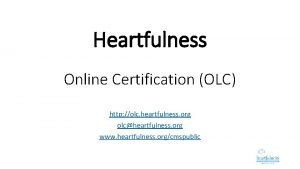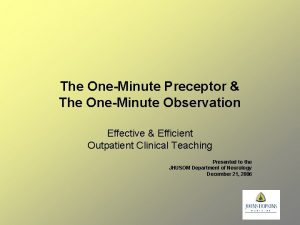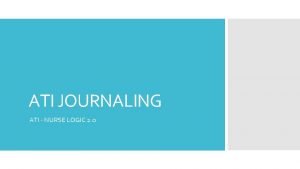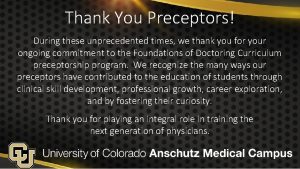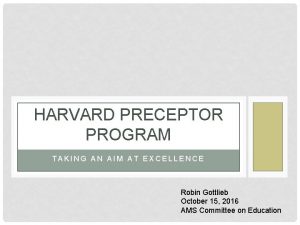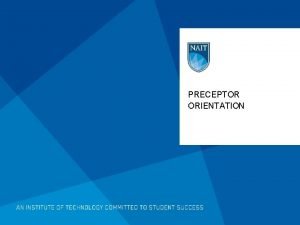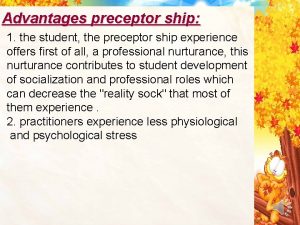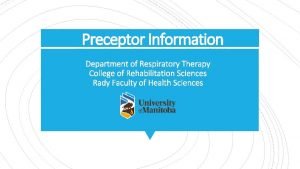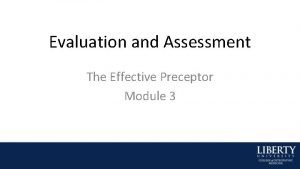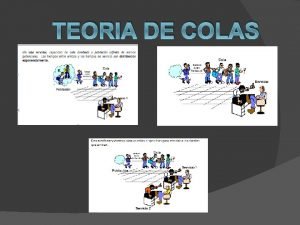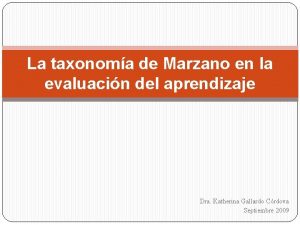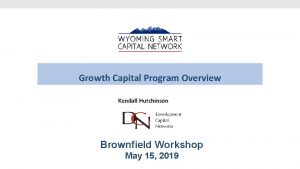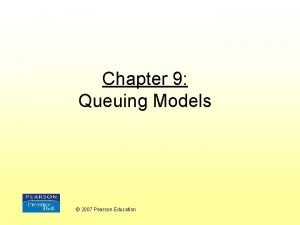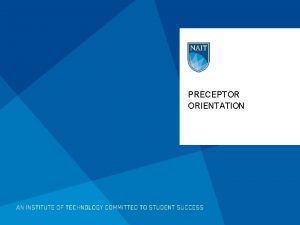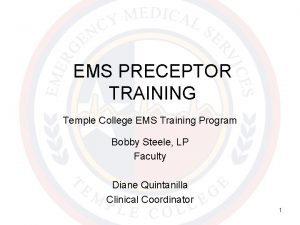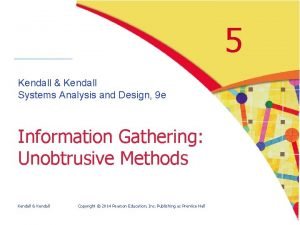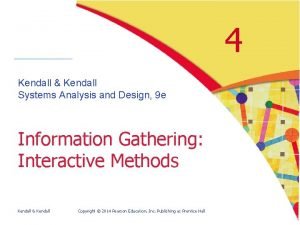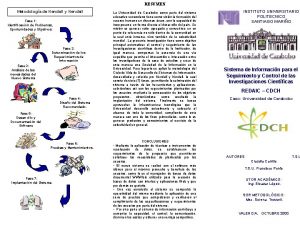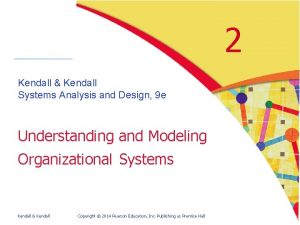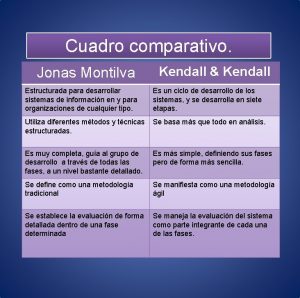MSDI Preceptor Training Program Anne Kendall Ph D




































- Slides: 36

MS-DI Preceptor Training Program Anne Kendall, Ph. D, RD, LDN Susan Brown, MS, RD, LDN

Learner Educational Objectives: Identify common characteristics of effective preceptors Identify key roles of the preceptor List examples of behaviors/strategies that are associated with effective precepting Effectively evaluate/deliver evaluations to the dietetic interns

Characteristics of Effective Preceptors: Organized and focused Value preceptor-student interactions Dynamic and enthusiastic Relate well to students Use an analytical approach Competent and confident Model professional behavior (Oermann 1996, Harden and Crosby 2000)

Positive Characteristics of Preceptors: Positive, enthusiastic attitude Provide appropriate, frequent feedback Show respect for student Challenge student to perform Question student and promote higher level thinking Provide appropriate structure (Allen-Chabot, 2006)

Characteristics of Preceptors that Interns View Unfavorably Feel uncomfortable when not introduced Want more feedback Feel uncomfortable when preceptor discussed other students with them Feel like they are a burden Feel overwhelmed (Allen-Chabot, 2006)

Characteristics of Interns Millennials ◦ ◦ ◦ Positive and confident Seek structure but without impeding their freedom Multitasking is a way of life Expect to always be connected Learning is like Nintendo, not logic Intolerant of delays

Characteristics of Interns Adult learners prefer learning situations that are: ◦ ◦ ◦ Practical and problem-centered Promote their positive self-esteem Integrate new ideas with existing knowledge Capitalize on their experience Allow choice and self direction

Characteristics of Interns Learning styles ◦ Visual learners: prefer to see your body language and facial expressions; will do better with written instructions; better understand client from the chart ◦ Auditory learners: interpret meaning through tone of voice, pitch and other nuances; will do well with case conferences and meetings, interviewing and instructing patients ◦ Kinesthetic learners: prefer a hands-on approach; will learn by practicing skills; be adept food production, anthropometric measures, demonstrating skills to others

Barriers to Learning: Inadequate knowledge due to: Lack of previous exposure to the information Too little review, study or preparation Incomplete or inaccurate information or confusion English as a second language Fatigue Disorganization Poor time management skills

Barriers to Learning: Poor work habits Poor attitude Lack of experience in applying theory to practice Discomfort working with those with illness Discomfort working with professional colleagues and/or employees Feelings of inadequacy Fear of making mistakes Unwillingness to venture out of one’s comfort zone

Barriers to Learning: Too much or too little self-confidence Stress Overly strong or weak personalities Learning disabilities: Attention Deficit Disorder, reading disorders, dyslexia, slow processing issues Medical problems

Roles of Preceptors: Planner Role model Information provider Facilitator of learning Resource developer Assessor of learning

Planning Learning: Competencies will intern achieve Knowledge, skills and experiences of the intern Learning activities needed to achieve competencies ◦ Will you set these up? ◦ If intern must interact with other practitioners or administrators, when will this occur, will you arrange these meetings? Plan for increasing intern responsibility

Planning Learning: What are emergency and backup plans How will the schedule and other information be communicated to all who need to know Orientation to facility ◦ Policies and procedures ◦ Dress code Make expectations clear: 80% of failures in the work place arise from unclear expectations

Preceptor Style: Do you expect interns to review plans for interacting with patients before approaching them? How and when should interns contact you? Do you want interns to make a decision and take action and then inform you or consult with you first? When an intern has a problem do you want him/her to solve it or come to you right away or something in between?

Preceptor Style: How will you approach problems related to intern behavior and performance? Expectations regarding learning/performance ◦ Will you discuss why you do what you do as well as how you do it? ◦ How many opportunities will an intern have to observe you before performing on his/her own? ◦ How will you when the intern is ready to progress? ◦ How will assess intern performance

Teaching Professionalism: a set of internalized character strengths and values directed toward high quality service to others through one’s work. Characterized by: Sound judgment Problem-solving Integrity Ability to work independently Dedication Perseverance Respect

Teaching Professionalism: Characterized by: Appreciation of diversity Cultural competence: the ability to discover the culture of each client/patient and effectively adapt interventions for her or him. (Curry 2000). Skills needed for cultural competence ◦ Become more knowledgeable about different cultures ◦ Develop flexibility in approaches/interventions ◦ Identify and/or develop culturally appropriate education approaches, techniques, and materials

Evaluation of Interns: Assessing student learning: Shared responsibility of the preceptor and UF faculty liaison Often the most challenging preceptor role Goal: to provide meaningful feedback for your student’s development. Feedback should be frequent, ongoing, and constructive. Aim for daily feedback.

Sharing Feedback with Students: Students like feedback, and often identify it as one of the most important characteristics of a good preceptor. Feedback is described as comments that: Let the student know what they have done well Let the student know what they need to improve Let the student plot a course of action

Students who Receive Regular Feedback about their Performance: Often perform significantly better Develop better judgment Learn faster than students who do not receive regular feedback Goal of feedback is for the student to become competent at the level expected at a given point in his/her education and to be ready to move on to the next rotation/experience.

Giving Feedback: Identify the purpose of feedback: to help the intern learn what it is that he/she is expected to be able to know and do (be specific) Identify strengths first before moving on to areas for improvement: sandwich method Describe behaviors the student needs to change or develop Back up comments with specific evidence and observations Prioritize the feedback by focusing on areas that are most important first

Giving Feedback: Share current and timely information Make comments descriptive rather than judgmental Consider the information the student noted in his/her self assessment Plan for follow-up feedback Develop an action plan

Giving Feedback: Provide feedback on a routine basis Make sure the feedback has been clearly understood: have intern summarize feedback and plan Avoid sending mixed messages Be honest in all of your feedback Be sure you have the evidence needed

UF MS-DI Evaluation. Tools: Education Skills Evaluation Form Interviewing Skills Checklist Counseling Skills Checklist Project Evaluation (Elective rotations) Evaluation of Core Competencies Evaluation of Professional Behavior Overall Summary of Intern Performance Evaluation of Rotation

Summary: Always be fair and ethical when providing feedback Formative feedback during rotation is consistent with final/summative evaluation No surprises at the final evaluation

Handling Difficult Situations: Primary Prevention: prevent the problem before it occurs ◦ ◦ Orient the intern well Set clear expectations and goals Determine the intern’s expectations and goals Reassess mid-rotation

Handling Difficult Situations: Secondary Prevention: early detection ◦ Pay attention to your hunches/clues ◦ Don’t wait ◦ Give specific feedback early and monitor closely

Handling Difficult Situations: Tertiary Prevention: manage the problem to minimize impact ◦ Seek help ◦ Don’t be a martyr ◦ Do not pass an intern who has not performed satisfactorily

Handling Difficult Situations: SOAP Approach ◦ Subjective: what do you and others think? ◦ Objective: what are the specific behaviors observed ◦ Assessment: form a differential diagnosis of the problem ◦ Plan: what next?

Handling Difficult Situations: Subjective ◦ Chief complaint: what made you think there was a problem? ◦ Has the intern been labeled? ◦ What do you/others think? ◦ What does the intern think – does s/he perceive a problem?

Handling Difficult Situations: Objective ◦ Identify and list specific instances of the behavior to document the issues ◦ Need specific information to intervene effectively

Handling Difficult Situations: Assessment ◦ ◦ ◦ Cognitive knowledge base Clinical skills less than expected Affective issues Values Environmental Medical

Handling Difficult Situations: Plan ◦ Gather more data? ◦ Get help ◦ Intervene

References: Allen-Chabot, A. M. (2006, May 25). Teaching in the Clinical Setting: Strategies for Success. Anderson, J. A. , Bueche, J. , Felton, A. , Fornari, A. B. , Gates, G. E. , La Potin, C. H. , et al. (2009, September 11). Dietetics Preceptor Training Program. Chicago, Illinois, United States of America. Curry, KR. Multicultural competence in dietetics and nutrition. J Am Diet Assoc. 100: 1142 -1143, 2000. Harden RM and Crosby JR. An extended summary of Association for Medical Education in Europe Medical Education Guide No. 20, Medical Teacher 22(4): 334 -347. (http: /www. amee. org) Oermann MH. A Study of Preceptor Roles in Clinical Teaching, Nursing Connections 1996 Winter; 9(4): 57 -64. Stenson, James B. “Professionalism and Workplace Savvy” www. parentleadership. com/worksavvy. html retrieved January 29, 2007

Free 8 -Hour CPEUs FREE! Online Dietetics Preceptor Training Program available on the CDR website. The program has 7 modules, is self-paced, and is good for eight (8) prior-approved CPEUs. The participant is allowed to stop and return after completing each module. Go to http: //www. cdrnet. org/ then scroll down to the title in the purple on the right side of the screen. Be sure to print your certificate of completion at the end.
 Kendall & kendall systems analysis and design
Kendall & kendall systems analysis and design Seven phases of the systems development life cycle
Seven phases of the systems development life cycle System analysis and design kendall
System analysis and design kendall Kendall system analysis and design
Kendall system analysis and design System analysis and design kendall
System analysis and design kendall Olc heartfulness
Olc heartfulness One minute preceptor method
One minute preceptor method Ambitos del pemce
Ambitos del pemce A nurse preceptor is orienting a newly licensed nurse
A nurse preceptor is orienting a newly licensed nurse Sanford avner
Sanford avner Harvard preceptor
Harvard preceptor Q and a criteria for judging
Q and a criteria for judging Thank you note to preceptor after orientation
Thank you note to preceptor after orientation Thank you note to preceptor after orientation
Thank you note to preceptor after orientation Preceptor ship
Preceptor ship Preceptor de nero
Preceptor de nero Bad preceptor
Bad preceptor Preceptor evaluation
Preceptor evaluation Kendall truitt
Kendall truitt Kendall and marzano taxonomy
Kendall and marzano taxonomy Kendall-lee notation
Kendall-lee notation Una doctora pasa en promedio 20 minutos con sus pacientes
Una doctora pasa en promedio 20 minutos con sus pacientes Diana kendall
Diana kendall Mm1 system
Mm1 system Notacion kendall teoria de colas
Notacion kendall teoria de colas Kendall's notation
Kendall's notation Taxonomia de marzano y kendall
Taxonomia de marzano y kendall Kendall alvarez
Kendall alvarez Wyoming smart capital
Wyoming smart capital Kendall vance model
Kendall vance model Larry kendall net worth
Larry kendall net worth Queuing models
Queuing models Kendall's notation
Kendall's notation Jack kendall rain neuromorphics
Jack kendall rain neuromorphics Marzano y kendall
Marzano y kendall Marzano y kendall
Marzano y kendall Unsend message to kendall
Unsend message to kendall





